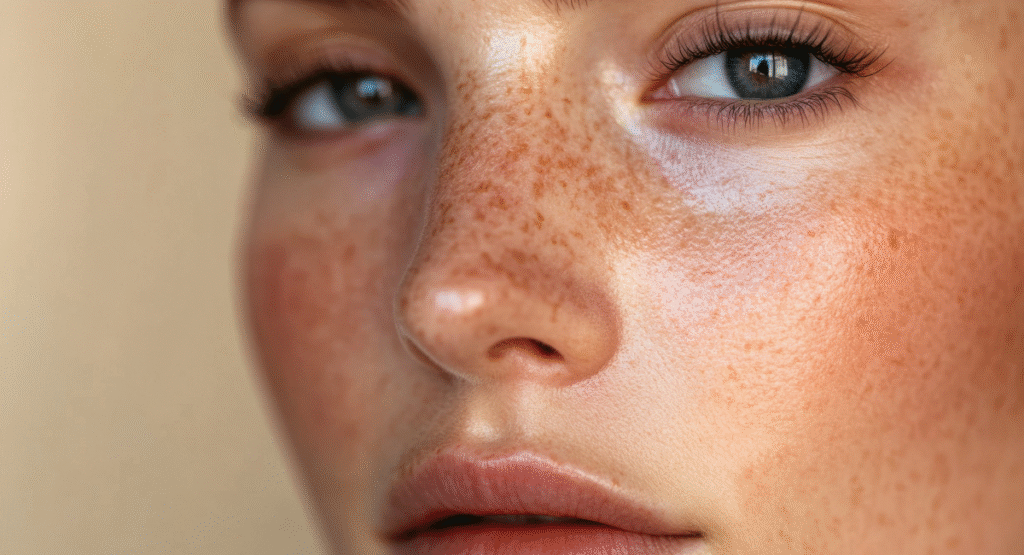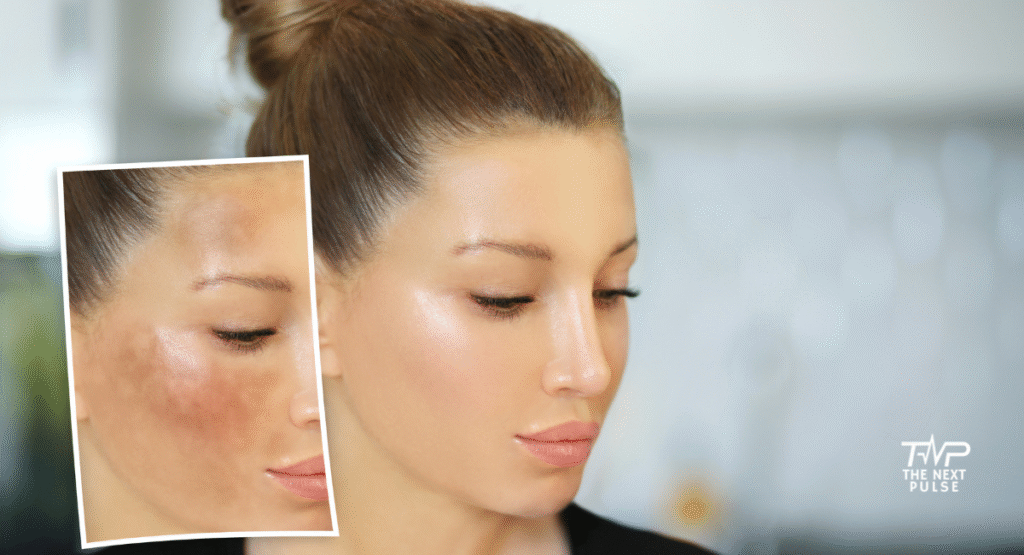
Freckles – Cute or Annoying?
Ever stepped out in the sun for 10 minutes and boom—next morning your nose looks like it got sprinkled with cocoa powder?
Some people find freckles adorable, others feel like they’ve been cursed by the sun gods.
Me? I think freckles are fine, but let’s be honest… when they darken and multiply like wild mushrooms after rain, it can get frustrating.
If you’ve ever Googled “how to lighten freckles without ruining my skin”, then you’re in the right place.
This isn’t about bleaching your face into oblivion, it’s about safe, slow, steady fixes that actually work
Why You’ll Love This Guide:
- Dermatologist-approved treatments for safe freckle removal
- Natural home remedies that work gently over time
- Prevention strategies to stop new freckles from forming
- Answers to your most frequently asked freckle questions
Let’s help you take control of your skin and even out your tone—naturally, effectively, and safely.
What Are Freckles? A Closer Look at This Common Skin Concern
What Exactly Are Freckles?
Freckles are flat, round, light to dark brown spots that commonly appear on the face, shoulders, chest, and arms. They are most often seen in individuals with lighter complexions (Fitzpatrick Skin Types I and II).
In dermatology, freckles are referred to as ephelides. They differ from solar lentigines (age spots) or melasma, though all fall under the umbrella of hyperpigmentation.
How Do Freckles Form?
Freckles form when the skin is exposed to ultraviolet (UV) rays, which trigger melanocytes to produce more melanin, the pigment responsible for skin color. Instead of spreading evenly, this pigment clusters in tiny patches, causing freckles.
Common Triggers for Freckles:
- Sun exposure – The number one factor; more sun = more freckles.
- Genetics – Often inherited, especially if you have red/blonde hair, green/light eyes, and fair skin.
- Lack of SPF – Skipping sunscreen makes freckles darker and more persistent.
- Age – While ephelides appear in youth, age can cause lentigines that resemble freckles.
Expert Note: Freckles are benign, but their presence may indicate increased skin sensitivity to UV radiation—making sun protection essential.

Dermatologist-Recommended Medical Treatments for Freckles
For those looking for faster or more dramatic results, the following clinically tested treatments are commonly used by dermatologists to lighten or remove freckles:
1. Topical Treatments
- Hydroquinone (2-4%)
A powerful skin-lightening agent that inhibits melanin production. Prescription required for higher strengths.
Results: 6–12 weeks
Use only under supervision to avoid rebound pigmentation. - Tretinoin (Retin-A)
Increases cell turnover and promotes fading of pigmented cells. Also treats fine lines and acne.
Results: 8–10 weeks - Vitamin C Serum
Antioxidant that brightens skin, reduces melanin clusters, and supports collagen.
Results: 4–8 weeks
2. Chemical Peels
- Mild to medium-strength peels (e.g., glycolic acid, salicylic acid) exfoliate upper skin layers and reduce pigmentation.
- Sessions: 2–3
- Redness and flaking may occur post-peel.
3. Laser Treatments
- Q-switched Nd:YAG lasers or Fractional Lasers precisely target pigmented cells.
- Visible results: After 1–3 sessions
- Best for: Deep or stubborn freckles
- Downtime may include redness, swelling, or temporary hyperpigmentation.
4. Cryotherapy
- Liquid nitrogen is used to freeze and destroy melanin-rich cells.
- Results: 1–2 sessions
- May cause mild scabbing or discoloration
Pro Tip: Always confirm freckles aren’t confused with precancerous spots. New, growing, or irregular lesions should be checked by a board-certified dermatologist.

Natural Home Remedies to Lighten Freckles Safely
If you prefer gentle, holistic solutions, these science-backed natural remedies may help fade freckles over time.
1. Lemon Juice + Honey
- Why it works: Vitamin C in lemon brightens, honey moisturizes and heals.
- How to apply: Mix 1 tsp lemon juice with ½ tsp honey, apply to freckles for 10 minutes, then rinse.
- Use 3x per week | Results in: 4–6 weeks
- Use only at night, and always wear SPF the next day.
2. Aloe Vera Gel
- Contains aloesin, a compound that suppresses melanin production.
- How to apply: Massage fresh aloe onto freckles daily.
- Results: 6–8 weeks
3. Yogurt or Buttermilk Mask
- Lactic acid gently exfoliates and lightens pigmentation.
- How to apply: Apply plain yogurt to affected areas, leave for 15 minutes, then rinse.
- Results: 3x per week | Visible effects in: 1–2 months
4. Turmeric + Milk Paste
- Turmeric contains curcumin, which reduces melanin synthesis.
- How to apply: Mix ½ tsp turmeric with 1 tbsp milk; apply for 10 minutes and rinse.
- Results: 4–6 weeks
5. Licorice Extract Serum
- Contains glabridin, which blocks melanin production.
- How to use: Use a licorice-infused serum at night.
- Results: 6–8 weeks
- Get from here: serum
Note: Home remedies take time and work best for lighter, surface-level freckles—not deeply pigmented or age-related ones.



Additional Tips: Preventing New Freckles & Maintaining Clear Skin
Daily Habits to Keep Freckles from Darkening:
- Use a broad-spectrum SPF 30+ daily
Reapply every 2 hours outdoors—even on cloudy days. - Cover up with protective gear
Hats, sunglasses, and UPF-rated clothing shield skin from harmful UV rays. - Eat an antioxidant-rich diet
Foods high in Vitamin C, E, and beta-carotene (e.g., citrus, berries, spinach) support healthy skin function. - Stick to a brightening skincare routine
Use Vitamin C in the morning and retinoids at night to prevent new pigment formation.
Pro Tip: Pair sunscreen with an antioxidant serum (like Vitamin C) in the morning for double the UV protection.
FAQ
1. Can stress cause freckles to appear or worsen?
No, stress doesn’t directly cause freckles, but it can increase skin sensitivity and inflammation—indirectly impacting pigmentation.
2. Do freckles turn into skin cancer?
Freckles themselves are not cancerous. However, any new, changing, or irregular pigmented spot should be examined by a dermatologist.
3. Will freckles go away with age?
Some freckles fade over time, especially with strict sun protection. Others may persist or evolve into age spots (lentigines).
4. Can exfoliation remove freckles?
Mild exfoliation can help fade surface freckles, but won’t remove genetically deep pigment.
5. Are there permanent treatments for freckles?
Laser therapy and cryotherapy offer the most lasting results, though recurrence is possible with UV exposure.

Final Thoughts: Freckles Are Natural—But You Can Treat Them Safely
At the end of the day, freckles are just your skin throwing a tantrum at the sun. They’re harmless, and honestly, many people love the look. But if you want a clearer, even tone, you’ve got options—both medical and natural.
Key things to remember:
- Protect your skin every day, no excuses.
- Natural fixes take time (6–12 weeks).
- Dermatologist treatments are faster but cost more.
- Always check strange spots before treating.
So yeah… freckles can stay if you love them, or fade if you don’t. Just use one thing: wear your sunscreen like it’s your favorite perfume

Soothe and Prevent Sunburn Naturally: Dermatologist-Approved Treatments, Home Remedies & Sun Safety Tips
Got a little too much sun and now you’re paying the price? We’ve all been there. One fun afternoon outdoors can turn into days of burning, peeling, and discomfort. Whether you forgot to reapply sunscreen or underestimated the intensity of UV rays, sunburn isn’t just painful—it’s your skin’s cry for help.
